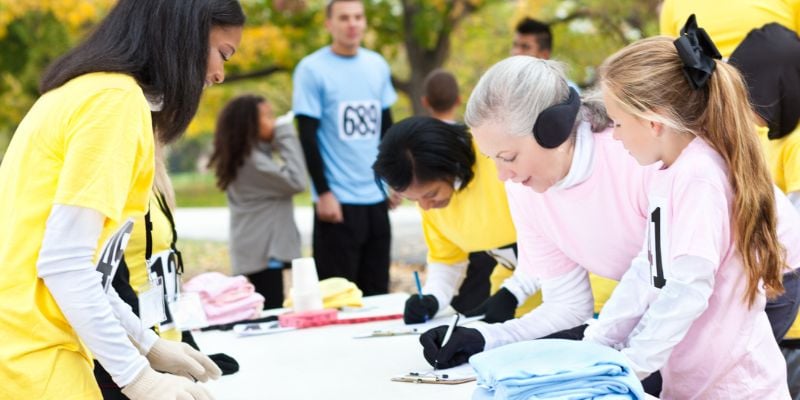Fundraisers are an important way for nonprofits and faith-based organizations to raise money and awareness for their cause. Organizing a successful fundraiser takes planning, creativity, and dedication. In this blog post, we will go over some key steps to help you organize a fundraiser for a nonprofit organization.
What you'll find in this guide (click on a topic to jump to that section):
- Nine simple steps for planning a successful fundraising event
- How to decide what type of event to host
- Tips for creating a memorable theme for your fundraiser
- Theme ideas that work well for nonprofit events
- Strategies to boost attendance
- How to accept donations
- Following up after your event
- General tips for growing your donor base
9 Simple Steps for Planning a Successful Fundraising Event
1. Define Your Goals and Objectives
The first step in organizing a fundraiser is to define your goals and objectives. What is the purpose of the fundraiser? How much money do you want to raise? What are the specific needs of the non-profit organization? Once you have a clear understanding of your goals, you can start planning the fundraiser.
2. Create a Budget
Creating a budget is crucial in organizing a fundraiser. Determine the expenses you will incur, such as venue rental, decorations, food and beverages, advertising, and any other costs. Make sure to include these expenses in your budget and plan accordingly.
3. Choose a Fundraising Idea
Choosing a fundraising idea that resonates with your target audience is important. It could be a silent auction, a gala dinner, a charity walk, or any other creative fundraising event. Make sure the fundraiser aligns with the mission of the non-profit organization.
4. Recruit Volunteers
Organizing a successful fundraiser requires a team effort. Recruit volunteers who are passionate about the cause and willing to commit time and effort. Assign roles and responsibilities to each volunteer to ensure the event runs smoothly.
5. Set up Ticketing and Payments
You’ll need a way to accept donations for your fundraiser and to register guests who are attending. Look for an online ticketing platform with features designed for nonprofit, such as pay-what-you-can tickets and the ability to donate or tip during an event.
6. Promote the Fundraiser
Promoting the fundraiser is crucial in ensuring that people are aware of the event. Use various marketing channels such as social media, email marketing, flyers, and posters to spread the word about the fundraiser. Consider partnering with local businesses or media outlets to increase awareness.
7. Secure Donations
Solicit donations from local businesses, individuals, and other organizations. These could be in the form of cash donations, items for a silent auction or raffle, or food and beverages for the event. Make sure to acknowledge and thank donors for their contributions.
8. Host the Fundraiser
The big day has arrived, and it’s time to host the fundraiser. Make sure to have everything organized and ready to go. Greet guests as they arrive and make them feel welcome. Ensure that volunteers are available to answer any questions and guide guests throughout the event.
9. Follow-up with Donors and Volunteers
After the fundraiser, make sure to thank donors and volunteers for their contributions. Share the results of the fundraiser, such as the amount of money raised and how it will be used by the non-profit organization.
Organizing a successful fundraiser requires careful planning and execution. By following these key steps, you can help raise money and awareness for a non-profit organization and make a positive impact in your community.
Decide What Type of Fundraising Event you Want to Host
There are many different types of fundraising events, but finding the right one for your nonprofit or faith-based organization is key. It should be aligned with your mission and include activities that appeal to your donors.
Here are just a few ideas:
- Charity Walk/Run - Participants register and pay to walk or run a certain distance, with the proceeds going to your nonprofit.
- Silent Auction - Supporters donate items to be auctioned off and attendees place bids on the items, with the highest bidder winning.
- Benefit Concert - Host a concert featuring local or national musicians, with ticket sales going to your nonprofit.
- Charity Gala - A formal event with dinner, drinks, and entertainment, with proceeds going to your nonprofit.
- Online Giving Day - Encourage donors to give online on a specific day to reach a fundraising goal.
- Charity Golf Tournament - Host a golf tournament with registration fees going to your nonprofit.
- Virtual Talent Show - Encourage participants to showcase their talents virtually, with proceeds going to your nonprofit.
- Cooking Competition - Host a cooking competition with participants paying to enter and attendees paying to sample the food.
- Benefit Film Screening - Host a screening of a popular or inspiring film, with proceeds going to your nonprofit.
- Online Auction - Host an auction with items donated by supporters, with proceeds going to your nonprofit.
- Online Raffle - Sell raffle tickets online with a chance to win a prize, with proceeds going to your nonprofit.
- Benefit Fashion Show - Host a fashion show featuring local designers or boutiques, with ticket sales going to your nonprofit.
- Virtual Dance Party - Host a virtual dance party with attendees donating to your nonprofit.
- Charity Car Wash - Host a car wash with volunteers and attendees paying to get their cars washed.
- Benefit Comedy Night - Host a comedy show featuring local or national comedians, with ticket sales going to your nonprofit.
- Bake Sale - Host a bake sale with supporters baking and selling treats, with proceeds going to your nonprofit.
- Online Trivia Night - Host an online trivia night with attendees paying to participate and win prizes.
- Charity Auction - Host a live auction with high-end items donated by supporters, with proceeds going to your nonprofit.
- Benefit Art Exhibition - Host an art exhibition featuring local artists, with proceeds from sales going to your nonprofit.
- Online Book Club - Host an online book club with participants donating to your nonprofit to join.
How to Choose a Theme for Your Fundraising Event
Choosing the right theme for your fundraising event is important because it can help to make the event more memorable and enjoyable for attendees. Here are some steps you can take to find the right theme for your fundraiser:
- Consider your nonprofit's mission: Your theme should align with your nonprofit's mission and purpose. Think about the cause you are supporting and consider themes that tie in with your mission.
- Understand your audience: Your theme should be appealing to your target audience. Think about the age range, interests, and preferences of your audience and choose a theme that resonates with them.
- Consider the event venue: The venue can also help to guide your theme selection. If your venue has a particular theme or aesthetic, consider incorporating it into your gala theme.
- Look at past events: If you have hosted fundraising galas in the past, consider what themes were successful and well-received. Look at attendee feedback and consider repeating a successful theme or tweaking it for a fresh approach.
- Brainstorm with your team: Gather input from your planning team and brainstorm a variety of theme ideas. Consider creating a theme board with images, colors, and decorations to help visualize the different options.
- Conduct research: Do some research on popular event themes, both locally and nationally. Consider what themes are currently trending or popular on social media.
- Be creative: Don't be afraid to think outside the box and come up with unique and creative themes that haven't been done before. This can help your gala stand out and be memorable.
By taking these steps, you can find the right theme for your fundraising gala that aligns with your mission, resonates with your audience, and creates a memorable experience for attendees.
Ideas for a Fundraising Event Theme
Need some inspiration for your fundraiser’s theme? Try one of these ideas:
- A Night in Paris: Bring the romance and glamour of Paris to your gala with French-inspired decor, food, and music.
- Black Tie Masquerade: Create an air of mystery and elegance with a masquerade theme, featuring black tie attire and masks for guests.
- Hollywood Glam: Roll out the red carpet and host a Hollywood-inspired gala, complete with a photo booth and celebrity impersonators.
- Enchanted Forest: Create a magical, woodland-inspired atmosphere with fairy lights, foliage, and forest-inspired decor.
- Winter Wonderland: Bring the beauty of winter indoors with a white and silver color scheme, snowflake decor, and cozy blankets.
- Vintage Circus: Step right up to a vintage circus-themed gala, complete with performers, carnival games, and circus-inspired decor.
- Arabian Nights: Transport guests to a magical Middle Eastern bazaar with colorful fabrics, lanterns, and belly dancers.
- Mardi Gras: Host a festive Mardi Gras-themed gala, featuring a New Orleans-inspired menu, masks, and beads.
- Garden Party: Celebrate spring with a garden party theme, featuring floral decor, a live band, and outdoor games.
- Great Gatsby: Embrace the glitz and glamour of the Roaring Twenties with a Great Gatsby-themed gala.
- Fire and Ice: Play with contrasting elements of heat and cold with a fire and ice theme, featuring warm and cool decor and lighting.
- Nautical Nights: Host a nautical-themed gala with a blue and white color scheme, boat-inspired decor, and seafood on the menu.
- Disco Fever: Get guests dancing with a disco-themed gala, featuring a disco ball, '70s-inspired outfits, and funk music.
- Around the World: Take guests on a trip around the world with food, decor, and entertainment inspired by different countries.
- Broadway Nights: Host a Broadway-inspired gala with live musical performances, a red carpet entrance, and theater-inspired decor.
- Crystal Ball: Create a mystical, ethereal atmosphere with a crystal ball theme, featuring crystal-inspired decor and a fortune teller.
- Art Deco: Celebrate the elegance of the Art Deco era with a black and gold color scheme, geometric decor, and jazz music.
- Casino Royale: Host a James Bond-inspired casino night gala, featuring casino games, martini cocktails, and suave attire.
- Sports Night: Host a sports-themed gala, featuring a live sports game screening, sports memorabilia auction, and team colors as decor.
- Beach Bash: Bring the beach to your gala with a tropical color scheme, beachy decor, and live steel drum music.
Boost Attendance to Your Fundraising Event
Getting people to attend a fundraising event is crucial to its success. Here are some strategies to help you get more people to attend your fundraising:
- Leverage your network: Start by promoting your event to your existing network. Ask your friends, family, and colleagues to spread the word about the event and invite others to attend.
- Utilize social media: Use social media platforms such as Facebook, Twitter, and Instagram to promote your event. Create an event page and share it with your network. Ask your followers to share the event with their networks as well.
- Email marketing: Send out targeted emails to your supporters and invite them to the event. Make sure to personalize the message and highlight the value of attending the event.
- Local media outreach: Reach out to local media outlets such as newspapers, radio stations, and TV stations. Ask them to promote the event and consider covering it as a news story.
- Partner with other organizations: Collaborate with other local organizations that share a similar mission or target audience. Cross-promote the event with their network and invite them to attend.
- Offer incentives: Consider offering incentives to attendees such as discounted tickets, free gifts, or exclusive access to the event.
- Utilize paid advertising: Consider using paid advertising such as Facebook Ads or Google Ads to reach a larger audience.
- Partner with influencers: Partner with influencers who have a large following in your target audience. Ask them to promote the event to their followers and attend the event.
By utilizing these strategies, you can increase awareness and attendance at your fundraising event, which will help you reach your fundraising goals.

How to Accept Donations to Your Fundraising Event
Accepting donations for your nonprofit or faith-based organization is essential to reaching your fundraising goals. Here are some ways you can accept donations at your event:
- Silent auction or raffle: You can hold a silent auction or raffle and allow guests to bid on or purchase items with proceeds going to your nonprofit.
- Online donation platform: Set up an online donation platform and encourage guests to donate via their mobile devices. This can be done through a QR code or a short link that directs them to the donation page.
- Donation box: Place a donation box at the event where guests can make cash or check donations. Make sure to clearly label the box with your nonprofit's name and mission.
- Live auction: Hold a live auction and allow guests to bid on high-value items or experiences. Make sure to have an auctioneer to help drive up bids.
- Fundraising thermometer: Set up a fundraising thermometer to show the progress towards your fundraising goal. This can help to create a sense of urgency and encourage guests to donate.
- Text-to-donate: Set up a text-to-donate service and encourage guests to donate via text message.
- Sponsorships: Offer sponsorship packages for businesses or individuals to make a donation in exchange for recognition and marketing opportunities at the event.
By providing multiple donation options, you can make it easy for guests to donate and increase the likelihood of reaching your fundraising goals. Make sure to promote the donation options throughout the event and to express your appreciation for any contributions made.

After the Event
Following up with guests after your fundraising event is important to show your appreciation and to keep them engaged with your nonprofit. Here are some ways you can follow up with your guests:
- Thank-you email: Send a personalized thank-you email to all attendees. Include a heartfelt message of appreciation and let them know how their support will make a difference.
- Phone call: Consider making a phone call to thank guests for attending the event and for their support. This can help to deepen the relationship and show that you value their support.
- Feedback survey: Send a feedback survey to attendees to gather feedback on the event. Ask for suggestions for improvement and consider implementing some of the feedback for future events.
- Social media: Post a message on social media thanking attendees for their support and sharing photos or videos from the event. Encourage them to share their own photos and feedback on social media as well.
- Follow-up event: Consider hosting a follow-up event for guests who attended the fundraising event. This can be a great opportunity to continue to engage with them and to build on the momentum of the initial event.
- Donor recognition: Consider recognizing donors who made a significant contribution at the event. This can be through a thank-you letter or by including them in a donor recognition program.
By following up with your guests after the fundraising event, you can show your appreciation, gather feedback, and continue to engage with them. This can help to build a strong relationship and increase their likelihood of supporting your nonprofit in the future.

General Tips for Growing Your Donor Base
Finding new donors for a nonprofit or faith-based organization can be challenging, but there are several strategies you can use to increase the likelihood of donations. Here are some ways to grow your donor base:
Create a compelling mission statement
Your mission statement should clearly and concisely explain what your nonprofit does and why it's important. A well-crafted mission statement can help potential donors understand the impact of their contributions and inspire them to support your cause.
Build relationships with donors
Develop relationships with donors by communicating with them regularly, thanking them for their support, and keeping them updated on the work your nonprofit is doing. Personalized communication and donor recognition can help build trust and increase the likelihood of repeat donations.
Provide multiple donation options
Offering different donation options can make it easier for potential donors to contribute to your organization. Consider accepting online donations, offering recurring donations, or providing donation matching programs.
Host fundraising events
Hosting fundraising events can help attract new donors and raise awareness about your nonprofit. Consider hosting events such as charity walks, auctions, or galas. These events can create a sense of community around your organization and provide an opportunity to share your mission with others.
Utilize social media and email marketing
Use social media and email marketing to reach a larger audience and keep donors engaged. Share updates on your nonprofit's work, success stories, and upcoming events. Consider creating a social media campaign or email newsletter to keep donors informed and connected to your organization.
Partner with businesses and other organizations
Partnering with businesses or other organizations can help increase visibility and attract new donors. Consider working with local businesses to sponsor events or offer donation matching programs. Partnering with other nonprofits can also help raise awareness and create mutually beneficial relationships.
Provide transparency and accountability
Donors want to know that their contributions are making a difference. Providing transparency and accountability can help build trust and encourage donations. Share how donations are being used and provide regular updates on the impact of your nonprofit's work.
Finding new donors requires a multifaceted approach. By creating a compelling mission statement, building relationships with donors, offering various donation options, hosting fundraising events, utilizing social media and email marketing, partnering with businesses and other organizations, and providing transparency and accountability, you can increase the likelihood of donations and make a positive impact on your cause.
Final Thoughts
Hosting a fundraising event for your nonprofit or faith-based organization offers an excellent opportunity to raise awareness for your mission, increase donations, and meet your supporters face-to-face. A successful event starts by identifying a clear objective. Then, analyze your target audience to determine the right type of event and a theme that will appeal to current and potential donors. Communication before, during and after your fundraiser will help maximize your impact.
Accepting donations and registrations is a key component of any fundraising event. Passage was designed with the features nonprofits need most, including pay-what-you-can tickets, donor memberships, product or donation upsells, assigned seating, and more. Schedule a demo to learn how you can use our mobile box office to grow your donor base.















